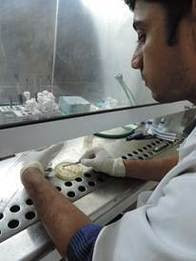
October 2014 | CDC Responds to Ebola Outbreak |
CDC Experts Respond to Ebola |

CDC staff from across the agency are responding to the largest Ebola outbreak in history, affecting multiple countries in West Africa.
Food safety leaders Drs. Chris Braden and Robert Tauxe, along with a number of other food safety staff, have been deployed to CDC's Emergency Operations Center (EOC) and in the field to offer their epidemiology, laboratory, and communications expertise to the Ebola response.
This is the largest outbreak of Ebola in recorded history, and we anticipate our staff being engaged in the response efforts for the foreseeable future.
As of October 25, 2014:
Total Cases: 10,114
Laboratory-Confirmed Cases: 5,666
Total Deaths: 4,912
Outbreak distribution map of areas most affected by
Ebola in West Africa
Infographic on how Ebola is spread
As of 10/23/2014, 54 staff from the Division of Foodborne, Waterborne and Environmental Diseases have responded to the epidemic, or are scheduled to deploy in the near future.

Quick Win in India
India estimates that 70% of illnesses and outbreaks are caused by acute diarrheal diseases. Understanding what comprises this significant disease burden is a national priority and the focus of a pilot project by India’s CDC (NCDC) in partnership with theGlobal Disease Detection Center (GDD) Regional Center.
CDC reference laboratory experts and communications staff traveled to India as part of a Global Health Security (GHS)“Quick Win” project to kick-start this work. The trip was the first phase of intensive training in two Indian states (Tamil Nadu and Gujarat) through four pilot sites. The goal of the pilot program was to accurately identify and characterize antibiotic susceptibility of enteric pathogens. These findings will help quantity the large burden of illness so that effective prevention measures can be implemented. Success in these pilot states will be reproduced throughout India. In September, the India trip was mentioned in the White House Meeting "Quick Win Report."

Outbreaks!
Recent Investigations of Foodborne Outbreaks Reported on CDC.gov:
CDC and federal, state, and local public health partners are continuing surveillance to identify and interview ill persons and to identify sources of infection. Read more about current outbreak investigations:
Final Update: Multistate Outbreak of Human Salmonella Infections (Announced October 21, 2014)
Cilantro Cyclosporiasis (Announced August 2014)
Nut Butter Salmonella (Announced August 2014)
Foodborne outbreak investigations go through several steps to ensure that the public, industry, and researchers have access to timely and accurate information. Learn more about the steps in investigating foodborne outbreaks.

Partners
Antibiotic Resistance:
CDC works closely with a number of partners to address foodborne infections from resistant bacteria. These partners include federal agencies, state and local health departments, the food industry, healthcare providers, and academia.
New and improved! CDC's Antimicrobial Resistance and Food Safety page is now live.
You can learn more about CDC's role in combating antibiotic resistance from the following resources:
- Medscape: Clinical Impact of Antibiotic-Resistant Salmonella
- CDC Feature: Be Food Safe: Protect Yourself from Food Poisoning
- CDC Website: Office of Antibiotic Resistance (OAR)
Collaboration on Food Safety and Antibiotic Resistance:
- FDA is reporting a 16% increase in the quantity of medically important antimicrobials sold for use in food animals from 2009-2012: FDA Annual Summary Report on Antimicrobials Sold or Distributed in 2012 for Use in Food-Producing Animals.
- Food Safety News: Overuse of Antibiotics Nearly Doubled Clostridium Difficile Infection Rate.
- The National Institute for Animal Agriculture (NIAA) is hosting a conference in Atlanta November 12-14 on antibiotic resistance through shared stewardship. CDC subject matter experts will be presenting at the conference on the importance of antimicrobial resistance and its impact on human and animal health.
Coming Next Month:
Spotlight on antimicrobial resistance and food and animal agriculture through shared partnerships

Publications
Spotlight on Botulism:
Marshall KM, Nowaczyk L 2nd, Raphael BH, Skinner GE, Rukma Reddy N. Identification and genetic characterization of Clostridium botulinum serotype A strains from commercially pasteurized carrot juice. Food Microbiol. 2014 Dec;44:149-55
Raphael BH, Shirey TB, Lúquez C, Maslanka SE. Distinguishing highly-related outbreak-associated Clostridium botulinum type A(B) strains. BMC Microbiol. 2014 Jul 16;14(1):192.
Raphael BH, Bradshaw M, Kalb SR, Joseph LA, Lúquez C, Barr JR, Johnson EA, Maslanka SE.Clostridium botulinum strains producing BoNT/F4 or BoNT/F5. Appl Environ Microbiol. 2014 May;80(10):3250-7.
Gonzalez-Escalona N, Timme R, Raphael BH, Zink D, Sharma SK. Whole-genomesingle-nucleotide-






















.png)











No hay comentarios:
Publicar un comentario